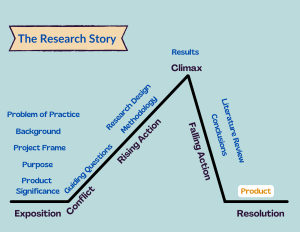Capstone Components
17 Product Plan
The story continues…
The friends’ theory matched up with what was happening in reality. Pickles could probably take care of three, maybe even four, mice at a time in Harry’s home. Harry is happy that Pickles should finally have fun catching the mice if he does his job of limiting the number of mice Pickles encounters. Harry is also happy he can finally protect his favorite cheese. Yet, for Physicus, a simple application of research findings is only a part of the victory.
Physicus said, “You know Harry, we need to build a product we share with others.”
“But, I am happy now. Pickles caught three mice this morning,” said Harry.
“Your cheese is safe! Terrific! However, we need to build a strategy that other cat owners can use to keep their cheese safe, too.” Physicus explained.
“Perhaps the other methods we learned about will get rid of mice even faster!” exclaimed Harry.
“Perhaps. Research is how we find evidence and strategies to mitigate our problems. We need to share what we learned with other cat owners by putting it into a product that is easily accessible. What strategies should we include in our product?” asked Physicus.
“I guess it depends!” laughed Harry. “Are you buying the pizza?”
Interpreting the Story
Physicus’ point about providing a product to share is a very important one. The friends learned some valuable information other cat owners would want to know. The friends learned how to influence of Pickles’ behavior to solve the problem. Sharing their strategies is important for other cat owners looking to solve a similar problem.
Essential Elements and Outcomes
The Essential Elements and Outcomes heading is found in Chapter 3 of the capstone project. It functions as an overview of the product. The writing explains the specific elements that must be included in the product. The essential elements are determined from both the needs assessment findings and findings presented in the Literature Review from Chapter 2. The writing also explains why the essential elements will effectively address the problem.
The outcomes of the product are also detailed in the heading. The outcomes specify what is achieved by implementing the product. Outcomes are observable results or changes that provide a solution to the problem in a given context. The writing explains how the outcomes fulfill the purpose of the capstone project. The outcomes also guide the evaluation methods used to measure the success of the implemented product.
Product Development
The Product Development heading delineates the specific steps used in developing the product. The writing identifies who is involved in the process, what and how each step is carried out, and the timeline for completion. The heading also describes the resources needed to complete each step of the plan. A chart may or may not be used to convey the basic information.
The Product Development heading explains how the steps of the development process are supported by specific empirical evidence from Chapter 2 of the capstone project. The writing references the findings of the Needs Assessment and explains how the product addresses those needs. Additionally, an argument is presented for how the product is structured to meet the essential elements and to reach the intended outcomes of the product.
Implementation Strategy
The Implementation Strategy heading discusses how the product plan is executed in the local educational context. The writing explains the specific leadership strategies necessary to implement the product in this context. Effective communication, developing buy-in, facilitating collaboration, modeling, etc. are examples of leadership strategies discussed in this heading. The heading explains how these implementation strategies are employed to ensure the success of the product when implemented. The focus is on techniques the author uses to lead the execution of the product plan.
Evaluation Methods
The Evaluation Methods heading details the measures used to determine the success or effectiveness of the product when implemented. This heading reads similar to the Methodology heading. The quantitative or qualitative measures are discussed in detail. The goal and function of each measure are explained in relationship to the intended outcomes of the product. For example, if the product was a professional development series designed to improve the teaching and learning of X content, then the evaluation methods might include observations of teaching and student exam scores on X content. The writing communicates how the reader will know the product worked as intended.
Limitations and Barriers
The Limitations and Barriers heading details the potential challenges in the local context that affect the implementation of the product. Limitations are specific hurdles or complications that hinder the successful implementation of the product. Limitations may be large obstacles or small but are within the control of the author. For example, times available to deliver the product of professional development training may be a limitation, however, the author can work within the local context to find times that do not hinder the success of the training.
The heading also presents the barriers to implementing the product in the local context. Barriers are obstacles outside the control of the author that hinder the successful implementation of the product. For example, an institutional policy that requires professional development training sessions to be voluntary may be a barrier to having enough participants for a training session product. The writing in the heading explains both the potential limitations and barriers and how the implementation strategies or the product plan are designed in ways to avoid these.
telling the research story
The Product Plan chapter concludes the research story and provides the resolution. It tells the reader here’s how this quest is resolved. It provides a happy ending, in a sense, because the characters are left hopeful for life without the problem. While this story is over and the problem is solved, for now, the heading may also point to the next saga the educational research story.


